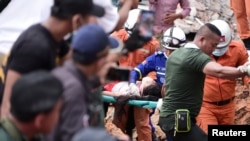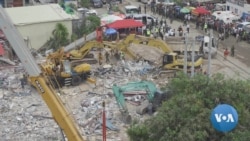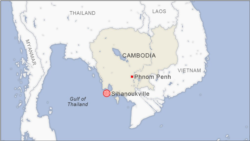Chhengpor Aun of the VOA Cambodian Service contributed to this report.
SIHANOUKVILLE, CAMBODIA — Nhor Sreyoun recruited her two younger brothers and sister-in-law to work with her on the construction site of a Chinese-owned building.
That was in April.
On Tuesday, seven people were charged in the fatal collapse of the building, hours after the three-day rescue operation to find survivors ended on Monday.
Nhor Sreyoun told VOA Khmer that she was “full of regret” that her younger brother, Nhor Chanthorn, 18, died six months before his planned wedding.
Twenty-seven others died, and her other brother and a sister in-law are among at least 26 people seriously injured when the building collapsed Saturday morning, burying workers who lived on the worksite.
“I should not have brought them here,” said the 32-year-old Nhor Sreyoun from Tboung Khmum, a poor rural province in the Mekong River lowlands.
Given the breakneck pace of Chinese-funded development in this once slow-moving coastal city that has become a boomtown filled with glitzy casinos catering to Chinese tourists, a building collapse seemed inevitable given lax permitting and more than a whiff of corruption.
In August 2018, the World Bank Group warned that development in Sihanoukville operated on “build first, license later” timeline, adding “The granting of permits and control of construction is beyond the authority of individual provincial departments and municipality.”
Among those charged over the collapse were building owner Chen Kun and construction supervisor Deng Xing Gui, both charged with involuntary manslaughter, causing unintentional injuries and damage, according to the Preah Sihanouk Provincial Court.
Three other Chinese nationals, a Vietnamese and a Cambodian were charged with conspiracy related to the charges, the court documents showed.
The Chinese Embassy expressed its deepest condolences to the victims in a statement that added its support for “a thorough investigation of the accident and necessary measures by competent Cambodian authority in accordance with the law.”
San Chey, the executive director of the Affiliated Network for Social Accountability Cambodia, an anti-corruption advocacy group, said much of the construction in Cambodia was unregulated. He called for a thorough investigation of the collapse.
Cambodia’s Prime Minister Hun Sen visiting the scene on Monday said “We will find out the case of the collapse and whether the building is legal or not.”
Authorities said the building was about 80% completed.
Yun Min, the provincial governor, said two warnings had been issued to the construction company owner but work had not stopped. “Some listen but some don’t and keep working stealthily like this one,” he told reporters as he visited the site.
Yun Min resigned on Monday and on the same day, Hun Sen fired the first vice president of the National Committee for Disaster Management, citing Nhim Vanda's "lack of responsibility and lying."
Nhim Vanda could not be reached for comment. Government spokesman Phay Siphan told VOA Khmer that “we also acknowledge his services to the national interests in the past."
Nhor Sreyoun told VOA she had worked at the site for about seven months before the accident. Like many of Cambodia’s rural residents, supplements her family’s income by working in the country’s big cities.
Speaking from the hospital where she tended her brother’s injuries, Nhor Sreyoun said the warnings meant work stopped for “one day, two days or three days,” she said, adding that there was one period in March when “the [Chinese manager] asked me to stop, saying that [there was] no more work."
But in April, the same man told her to return to work, asking if she knew other people who could work on the site. That’s when Nhor Sreyoun recruited her brothers and sister-in-law to come to work.
“Initially, it was to be a five-story building and then two more stories were added,” she said.
For four or five days, there was overtime pay as workers hauled material to the top floor. “Thousands of tiles and sack were brought to the top,” she said. “It was very heavy.”
Phat Sophal, 37, who has worked in construction for six years, said that he and his colleagues thought “the elevator wasn’t strong enough and we thought it would break. But it wasn’t the elevator that wasn’t strong enough, it was the building.”
Ros Sitha, Phat Sophal’s uncle in-law, was also trapped. Rescuers found Kak Kea and Ros Sitha, 40, alive in the rubble on Monday afternoon. “I thought they had died, but now they are OK,” said a relieved Sok Ros, a 41-year old farmer and Kak Kea’s father.
Nhor Sreyoun’s other younger brother, Nhor Channet, 30, said “when it fell, there was no way out. It is difficult to breathe since there is no enough oxygen.”
Then, as rescuers cleared the rubble “more and more fell. Even though we tried to shout for help, nobody heard us,” said Nhor Channet.
Nhor Sreyoun said that despite the fatal accident she will continue to work on construction sites.
“We are uneducated so there’s nothing else? that we can do,” she said. “I will work in construction but I will have to be more careful but my injured brother said he would stop because he’s afraid.”










